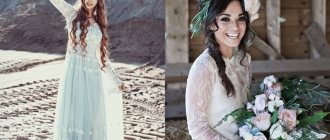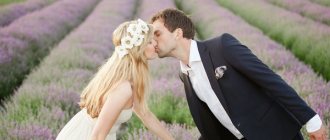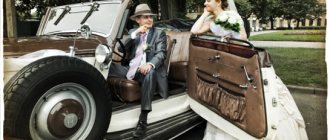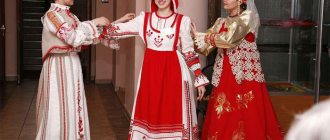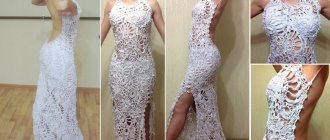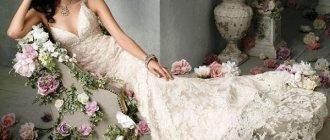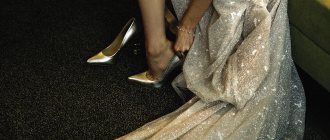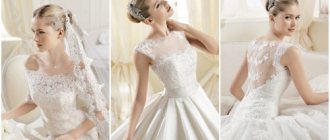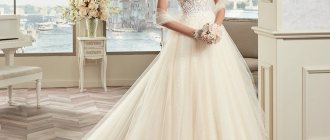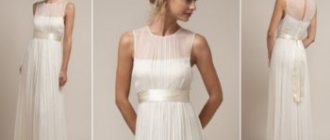Wedding clothes
- Antique wedding dress
- Early 20th century
- Wedding dresses of the 20s of the last century
- 30s style wedding dress
- Wedding fashion of the 40s and 50s
- Minimalism and rigor
- 80s wedding style
- Last decade of the last century
- Wedding dress 2000
Retro wedding dresses are an original and undoubtedly stylish opportunity for a bride to stand out among modern designs and silhouettes of wedding dresses.
Lush wedding dress in retro style
Vintage style usually includes styles, decorative elements, and unique solutions that appeared in wedding fashion at least thirty years ago . Styling a wedding dress in a retro style always attracts attention, because whatever you say, the last century was an era of exceptional femininity, romance and sophistication. The Soviet period does not count.
Wedding dresses in retro style are ideal for the image of a romantic and elegant bride.
Retro style in wedding fashion does not always mean vintage dresses with strange cut elements and elaborate trim. Vintage in a modern design can be represented by correctly selected material, dress color (and most often it is not snow-white, but natural milky or beige), decorative elements and accessories.
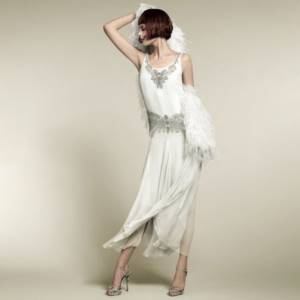
Photo of a bride in a wedding dress in retro style
When choosing extravagant models, it is recommended to take care of combining the bride’s outfit with the groom’s suit - you must admit, vintage feathers and a men’s business suit from Brook’s Brothers will look ridiculous next to each other. It is better if the entire wedding is designed in a retro theme : the interior of the ceremony room, the hairstyles of the invited ladies, the suits of the gentlemen and the final beautiful chord - the bride’s wedding dress in the same style.
Antique wedding dress
The concept “ancient” takes us back two or three historical centuries . Wedding dresses of those eras were seriously different in style from modern ones, and the color schemes were most often not snow-white at all. Since weddings in those days were rarely of a love nature, but more of a commercial nature, the bride’s dress reflected the wealth of her family and had to correspond to the social status of her future husband. These are expensive, usually refined and expensive materials brought from abroad: silk, satin, corduroy, velvet.
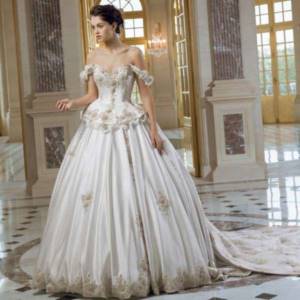
Photo of a 19th century retro wedding dress
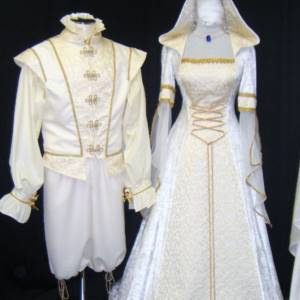
Wedding dresses in medieval style
Gold and pearl threads, the finest handmade lace, precious stones (emeralds, sapphires, rubies), and rich fur (mink or sable) were chosen as decoration.
The moral principles of that era dictated their own rules : dresses for the bride were closed, the chest and neck were not exposed, the hem was certainly “floor-length” and sleeves were of maximum length. The color of the wedding dress directly indicated the financial well-being of the bride’s family: materials for dresses dyed with natural pigments were expensive, and therefore only girls from a rich family could afford bright models in scarlet, pink or blue.
Natural colors of wedding dresses (milk, beige, natural linen) remained the lot of poor brides; fur decor consisted of hare or fox skins. When choosing an antique dress now, it is worth considering these symbolic moments.
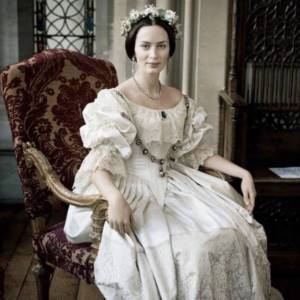
Photo of a wedding dress in a medieval style
In families of modest financial means, wedding dresses were made with the expectation that in the future such an outfit could be worn on any significant occasion. By modern standards, such a wedding dress will seem too practical and rustic , so designers usually use old styles, but make them from expensive textured fabrics with spectacular decoration.
Early 20th century
The beginning of the 20th century in women's wedding fashion was marked by a complete abandonment of fluffy multi-layered skirts and the use of crinoline. More and more , a wedding outfit is becoming similar to a classic dress : a fitted silhouette with a wide hem, a closed style with long sleeves, no neckline - even the neck is covered with a high stand-up collar.
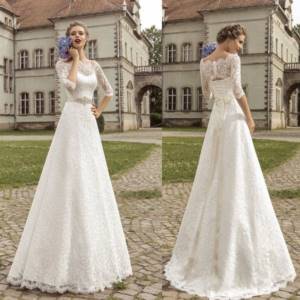
Photo of a dress for a bride from the early 20th century
The length of the dress is not as dramatic as before: now not only the toe of the shoe is visible, but also the graceful ankle. Seamstresses of that time began to abandon the widespread use of a corset in the style, but sometimes it is present in designs - it allows you to visually make the figure slimmer, lift the chest, straighten your posture, and create a clearer silhouette.
Wedding dresses of the 20s of the last century
The revolution took place not only in the political sphere of the country, but also in the fashion industry, and this could not but affect the outfits of fashionistas of that time. More and more often, modern brides are turning to the styles of that time: shortened models, very open and bold, appeal to the tastes of girls of the 21st century.
Nowadays, a retro wedding dress in the style of the twenties looks like a simple silhouette combined with expensive, original textured materials and luxurious decor. Currently, the fabrics chosen for such stylized dresses are airy and thin, matte or satin - chiffon, silk, satin. The lightness of the style is ensured by multi-layering and a bold combination of different textures of materials.
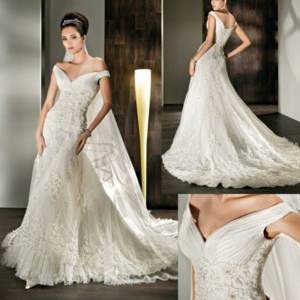
Wedding fashion of the 20s of the last century
The highlight of the bride's image of that time was a spectacular, rather deep neckline and a very low waist, literally down to the hips; often there was an asymmetrical hem that emphasized beautiful legs. The decoration must certainly be rich , otherwise the dress for the wedding ceremony will seem too simple: embroidery with pearls, beads or rhinestones, and decor with thin lace are actively used. Long large beads and massive brooches are recommended as accessories to maintain the retro style.
What does a retro dress for a bride look like?
It is impossible to describe the appearance of the retro dress unambiguously. In a broad sense, vintage models mean things created according to the style canons of the past; in a narrow sense, this is an image that spread in the period from the 20s to the 80s of the last century.
Fashion designers stubbornly refuse to say goodbye to this exquisite historical period; moreover, many draw inspiration for their collections from there.
It is not surprising that in the segment of wedding dresses there are more than enough vintage dresses!
Retro dresses are distinguished by light flowing fabrics. Minimalism? No, we haven't heard. The model, at a minimum, will be decorated with rhinestones, beads, glass beads or guipure. This trend traces old traditions; in the last century, festive vintage dresses were a sign of luxury, they were sewn for ladies in a single copy and more than one week of labor was spent on it.
The cut is often straight, but not tight. Vintage is lightness and a kind of innocence, which looks especially beautiful in combination with white. Dresses can be either long or short, and the waist can be high, low, or positioned where needed.
You definitely won’t find wide multi-layered skirts among retro models. On the contrary, the hem can begin to widen only in the knee area. And all because vintage is natural.
But don’t think that retro dresses are always closed, this is not true at all. An open back is allowed, which looks very sexy, open shoulders and a slight neckline. I would like to immediately note that a vintage dress is an ideal option for skinny women with small breasts and a boyish figure. This outfit will perfectly hide imperfections and make the image much more feminine.
We advise women with an hourglass figure to be careful when choosing retro dresses. After all, the skirt of such outfits is not fluffy and will not allow you to hide wide hips. But it will be great to hide your tummy; for this you just need to choose a model with a high waist and shift the emphasis to the shoulders.
Retro style is suitable for both thin brides and those with a few extra pounds. And all because vintage dresses make the bride look lighter.
Fabrics for retro dresses: silk, velvet, chiffon, knitwear.
30s style wedding dress
Femininity and elegance were the style of wedding designs of that time. Fitted silhouettes with clear shapes, complex cuts and sophistication in details make wedding dresses in the style of the thirties of the last century modern and luxurious. The styles are characterized by a neckline, a clearly defined waist and an elegant maxi hem design, often complemented by a moderate train. Femininity and lightness will be added to such a dress by spectacular draperies, which, in addition to visually equalizing the proportions, can hide significant figure flaws. The material chosen is soft, easily draped fabrics, plain with a matte surface.
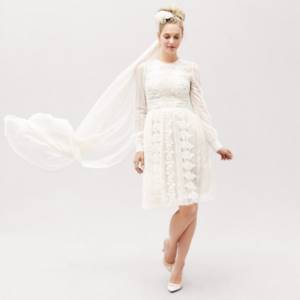
Retro style wedding dress with veil
Modern variations allow a medium length skirt , which in any case should cover the knee. Brides over 30 years of age often choose a wedding dress of this type: the beautiful figure is emphasized by an elegant cut, and the dress does not look daring. The look gains luxury due to expensive jewelry and stylish accessories: elbow-length gloves, a hat in the same style, a clutch to match the dress.
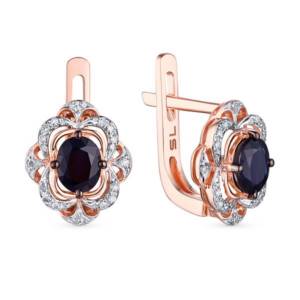
Gold earrings with sapphires and diamonds, SL (price on the link)
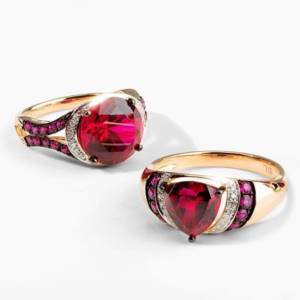
Gold rings with rubies and diamonds: first ring; second ring, all SL (prices follow links)
What to wear with a retro wedding dress
Particular attention should be paid to the selection of accessories and shoes for a harmonious retro look. The choice of additional elements should be based on the characteristics of the time from which the image itself was borrowed. For example, shoes in the form of shoes with a small stable heel with a semicircular toe and an ankle strap are typical for the 20s. But closer to the 60s, such shoes are replaced by more feminine pumps with thin stiletto heels.
A veil is an obligatory attribute of a wedding dress, but in retro style it can be successfully replaced with a hat with a wide brim or a mesh, as well as a hair garter. In Victorian style images and already in the 80s you can find a classic veil in retro outfits.
The 20s and 30s also feature gloves; they can be long, made of lace or openwork fabric. The retro look of the bride from the same years can be complemented with a fur cape or feathers.
Jewelry should be selected so that it fits harmoniously into the wedding look. For example, you can complement your outfit with a beautiful brooch or beads made of natural or artificial pearls.
Wedding fashion of the 40s and 50s
The Second World War made its own adjustments to people's lives in all directions. Destroyed industries, men who had not returned from the front lines - weddings at that time were a rarity in themselves, and wedding outfits were simple and even everyday . Only in the late 40s did the wedding industry begin to gain momentum, and the middle of the last century provided girls with the opportunity to get married elegant and elegant.
Romance has returned to people's hearts and wardrobes. Wedding dresses of the 50s are midi skirts, fitted styles, fluffy bottoms and neat, even formal tops. The emphasis is not on the complexity of the cut, but on the use of expensive airy (taffeta) or, conversely, materials that hold their shape (crepe). Lace trimming is done on a moderate scale, but the sewing is chosen to be of exceptionally fine workmanship.
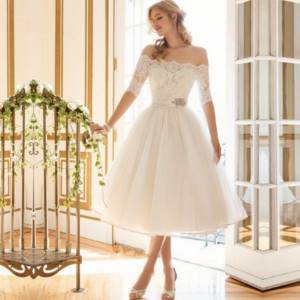
Wedding dress with retro patterns
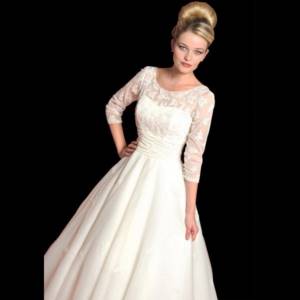
Photo of a Soviet era wedding dress
Minimalism and rigor
Simplicity and conciseness are the motto of wedding fashion for the next two decades.
Styles lose length, a bride's dress for a wedding in the style of the 60s looks extremely laconic, decor is used to a minimum and not always. In the silhouette, designers and seamstresses maintain strict geometry: a tight top and a fluffy bottom create ideal proportions for almost any figure. In the 70s of the last century, the shape of the skirt of wedding dresses took on an original shape - a bell or a bud.
Baroque style
A style came into fashion in the 13th century, which was characterized by outfits in silvery and delicate tones: light blue, light pink, light green, beige, cream, lilac, marble. The corsets strongly support the chest, and the wide skirts worn by Pannier. The most popular accessories used are feathers, lace, pearls, artificial flowers, fans and cameos. A bouffant hairstyle with feathers or flowers completes the look.
KNOWLEDGE BASE: The veil for a wedding is the most important detail after the dress
Baroque brides whitened their faces to such an extent that they looked like porcelain dolls. This style is suitable for girls who dream of looking like a princess at a celebration.
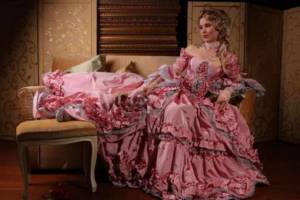
80s wedding style
Old 80s style wedding dresses truly look like a queen's outfit: they are luxurious and elegant . Silhouettes, as a rule, are kept in the classic “ballroom” style - long skirts, impressively designed, but often covered with translucent material, neckline, voluminous sleeves. The glamor and richness of the image is achieved through decor: rich embroidery appears on wedding dresses, and instead of a traditional veil, brides prefer hats or voluminous floral hair decorations. However, democracy and freedom have already entered the minds, hearts and wedding fashion: dresses for brides are becoming more and more original, and sometimes downright shocking. Wedding pantsuits became a hit in the 1980s.
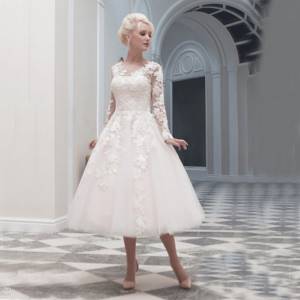
Retro style lace wedding dress
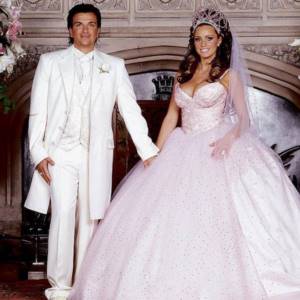
80s wedding dress
Rococo style: distinctive features
This style is a continuation of the Baroque style. The distinctive features between them include the following:
- Rococo focuses on youth, and Baroque on maturity.
- Rococo emphasizes sophistication and fragility, while Baroque emphasizes complexity and whimsicality.
- Rococo deliberately distorts the natural lines of the bride’s body, and Baroque expresses the abundance of decorations (bows, embroidery, ribbons, lace, etc.)
- Rococo is asymmetrical, dominated by light colors, while Baroque is symmetrical, dominated by dark, bright colors.
- Rococo emphasizes small details, while for Baroque the main thing is scale.
- For Rococo, smoothness in changing colors is important, and for Baroque, contrast is important.
- Rococo originated in France, and Baroque in Italy.
For comparison, we invite you to look at the photographs below, where a girl sitting in a red dress is wearing a Baroque style dress, and a girl in a pink dress is wearing a Rococo style dress:
KNOWLEDGE BASE: Wedding dress for short girls: which one to choose and how to become the most beautiful at the celebration
Last decade of the last century
By the end of the 20th century, the free wind of wedding fashion was slowly calming down, and brides were returning to the classic image of a fairy-tale princess . And this, first of all, is a traditional cut with bare shoulders, a defined waist and a full skirt. Crinoline and layered hemlines are coming back into fashion, with an abundance of lace decor, and color schemes are in shades of white (milk and ivory are beginning to appear on fashion catwalks).
The luxury and richness of the outfit, as before, is achieved through magnificent decor and expensive fabrics - any bride in a 90s-style dress looks like a true queen. An additional emphasis in the image is placed on a complex hairstyle, decorated with a medium or long veil.
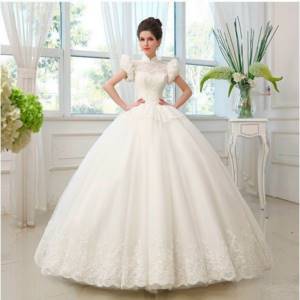
In the 90s of the last century, princess-style wedding dresses came back into fashion.
General features of dresses of past centuries
Ladies of that era were aware of their attractiveness and created images of coquettes with daring contrasts. Dresses were made of satin or satin, and accessories were fans, muffs and gloves. Women in such dresses resembled porcelain dolls with graceful arms, waists and hips rounded with the help of a fluffy Pannier skirt.
Medici collars and jewelry were used as additions to clothing, emphasizing solidity, audacity and confidence. A distinctive feature was oval-shaped skirts, decorated with rich embroidery, lace, silver and gold.
The style is characterized by luxury, pomp, sensuality, aristocracy, lace and ribbons.
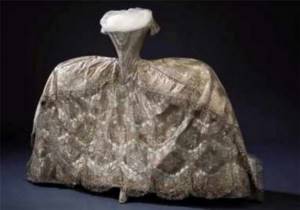
Wedding dress 2000
The year 2000 was a turning point not only in historical terms. There were no collapses in wedding fashion; certain restrictions on style, cut, and decor were simply lifted : some girls preferred daring mini-dresses, while more conservative ladies remained in classic wedding dresses. Fashion trends are unstable and democratic, or rather, they give the opportunity to try whatever your heart desires: straight and fitted styles, romantic decor and abstract prints, different lengths. For the first time in several centuries, along with traditional white and its shades, colored wedding dresses are appearing : pink, blue, scarlet.
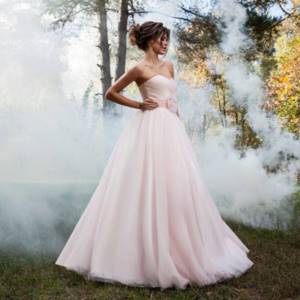
Photo of a wedding dress from 2000
